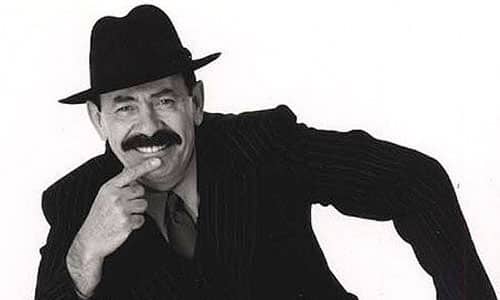The Stammer Of Success
When 53-year-old John Larkin couldn't get past his stuttering, he wrote a song about it. Soon enough, Scatman John was Big in Japan—and everywhere else.
Editor’s note: Hey guys, Ernie here. Our good pal Andrew Egan is back with an awesome tale about a guy who kicked adversity’s ass. Enjoy.
1.56M
The number of copies of Scatman John Larkin’s Scatman’s World that were sold in Japan alone—where it is the 11th-highest-selling international album of all time. Fueled by the massive popularity of the song “Scatman (Ski-Ba-Bop-Ba-Dop-Bop),” the album would go on to chart in 24 countries, including Canada, Germany, and the United Kingdom.

How a struggle with stuttering defined the life and career of Scatman John
The boy that would become the Scatman had a hard time growing up.
Born John Paul Larkin in El Monte, California in 1942, he developed a stutter early in his life that made communicating with others very difficult.
“As a child, I had to fight a few times,” Larkin said in a 1995 interview with Advance for Speech Pathologists and Audiologists Magazine. “I went into a rage a few times. I remember one instance where some neighborhood kids … mock[ed] my stuttering at the top of their voices. That really hurt. It just crushed me. I waited until the next day when they had forgotten about it. I didn’t. I ran after them, and the rage was so strong I would have killed them if my father hadn’t stopped me. But that pain, I hope, has made me into the good person that I try to be.”
Early in his life, music became a nonverbal source of creative expression. Larkin gravitated toward jazz piano and first learned about the scat style of singing listening to Louis Armstrong and Ella Fitzgerald. He successfully worked as a musician for decades, playing piano bars and festivals, until he finally released a self-titled album under his birth name at the age of 42.
By this point, Larkin had fallen into a time worn-pattern of drug and alcohol abuse, but had cleaned up by 1990. Well into middle age at this point, he decided to give his career one last push and moved to Berlin.
“After several months of going through the usual trials and tribulations of moving to another country and overcoming culture shock, Judy and I managed to secure an agent and I began to get booked into a European hotel circuit and I was well on my way to becoming the best hotel pianist I could be,” Larkin said in a statement posted on a fan website. “My feelings were … ‘Success at Last’ … I was so grateful to have actually had the opportunity to make a living as a musician. This, I thought, was as good as it could get.”
In Europe, he found greater acceptance of jazz, which inspired enough confidence that he incorporated singing into his act. Larkin reportedly received standing ovations for some of his performances.
“I began to own that I really could sing, that I was good,” Larkin said, according to The Los Angeles Times.
And once he found that confidence, things changed quickly for Scatman John.

What it’s like to have a career breakout at the age of 53
Larkin’s growing musical reputation eventually led to a music contract with BMG Hamburg, which had a unique idea to incorporate his jazz scatting with the house music dominating Europe at the time.
Eventually, he was teamed with producer Antonia Catania, who helped Larkin, then 53, create the surprise hit, “Scatman (Ski-Ba-Bop-Ba-Dop-Bop)“.
A uniquely ’90s blend of jazz scatting, rap, and house beats, “Scatman (Ski-Ba-Bop-Ba-Dop-Bop)” was released along with a video that made the rounds on MTV.
Though the song caused little reaction upon its initial release, steady airplay on mainstream radio gave it enough momentum to chart in two dozen countries, reaching number one in twelve of them, including Canada, Italy, and France. In the U.S., the single got has high as number 60 on the Billboard Hot 100.
In addition to strong album and single sales, Scatman also found a home for his music in entertainment and advertising. “Scatman (Ski-Ba-Bop-Ba-Dop-Bop)” was used in a Good Humor ad campaign and the 1996 Martin Lawrence/Tim Robbins buddy road comedy Nothing To Lose. As perhaps the ultimate sign of ’90s pop culture respect, the video was even featured in an episode of Beavis and Butthead.
“There should be a name for this kind of music,” Beavis notes.
“There already is a name for this kind of music, it’s called ‘crap,’” Butthead replies.
If it seems that Scatman had all the makings of a one-hit wonder, you’d largely be correct. His subsequent releases were met with a more muted reaction in Europe and the U.S., though he continued touring.
However, in 1997, Scatman’s third album became an unexpected hit in Switzerland and Japan, selling well over a hundred thousand copies.
And in Japan, he became something of a pop phenomenon, appearing in commercials. He even received his own impersonation, complete with trademark fedora and mustache on the iconic television series, Ultraman. He’s even the example used by TV Tropes for “Big in Japan.“
All of this begs an interesting question: Is an artist still a one-hit wonder if you just don’t know about the follow-up success?
Scatman John Coke cans, released in some European countries at the height of his success. (via Coke Collection)
Unfortunately, it would be Scatman John’s last moment in the limelight. He was diagnosed with lung cancer shortly after the release of his third album, but continued touring until his death in 1999.
From start to end, his career as a pop star lasted four years. But he embraced every moment of it, taking advantage of the platform he had to speak about the issues he really cared about—like stuttering.
“The fact that I’ve been a stutterer since I’ve been speaking has compelled me to find another way to speak another language. My greatest problem in my childhood is now my greatest asset. I’m trying to tell the kids today that Creation gave us all problems for a purpose, and that your biggest problems contain a source of strength to not only step over those problems, but all our other problems as well.”
— Scatman John, explaining in a speech to the National Association of Communicative Disorders (which he made after receiving an award) about his dedication to bringing awareness to the problem of stuttering—which, of course, was the subject of his most famous song.
The life of Scatman John was one of struggle, perseverance, talent, and addiction, but ultimately it’s a success story. For his contributions to stutterers (a word that is quite diabolical on closer inspection) everywhere, Scatman was enshrined in the National Stuttering Association’s hall of fame in 2000.
“Stuttering is an interesting thing,” he said, according to a Stuttering Foundation article. “I know how absurd it can sound for a stutterer to be told that it’s ‘okay’ to stutter. For me, now it is okay to stutter. I don’t like to stutter, but it has become okay. It kept me in the closet when I was a jazz player. Stuttering had control of me. I was a victim of my stuttering. Today I’m not the victim anymore. It doesn’t sabotage my life anymore.”
Whatever lesson you learn from Scatman John, good luck getting rid of the earworm his “one hit” has likely caused. Like his story, it sticks with you.
Andrew Egan is writer and editor of Crimes In Progress. His work has appeared in Forbes Magazine, ABC News, Atlas Obscura, Tedium, and more. You can read his article, “Any Which Way but Down or A Fair Amount of Male Nudity in the American West” in the December 2016 issue of Blue Skies Magazine. He is a graduate of the University of Texas at Austin. His novel, Nothing Too Original, is available now for Kindle and paperback. You can visit his website at CrimesInProgress.com.
:format(jpeg)/2018/04/oboh5kjbxxsqzict41fp--1-.gif)
/2018/04/oboh5kjbxxsqzict41fp--1-.gif)


/uploads/andrew_egan.jpg)